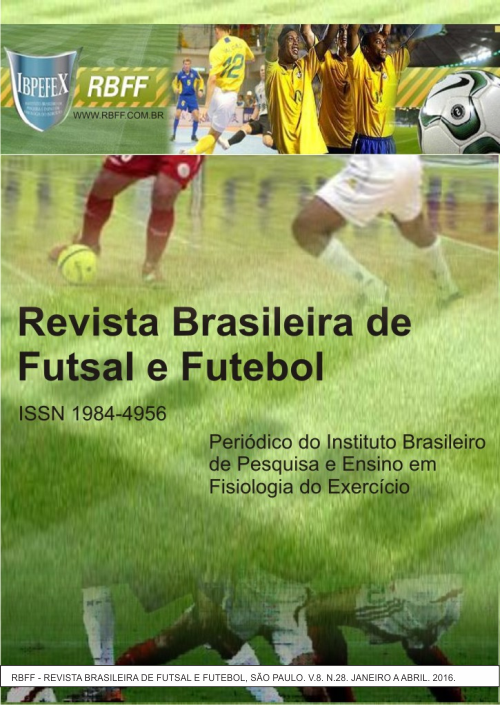Anthropometric identity of footbalers in the youth team U-17 of Chapecó-SC
Abstract
This study aimed to analyze the anthropometric profile of youth yeam footballers U-17 at Associação Chapecoense de Futebol, in 2014.The sample involved 23 male professional athletes of Football U-17 with a mean age of 16.52 ± 0.51 years, from ACF in 2014, all the population was part of the study. The anthropometric variables analyzed were body weight, height, skinfolds and bone diameters. The percentage of fat was estimated using the equation of Slaughter et al. (1988). The results show that the mean values of body composition were: Body Mass Index (BMI) of 22.43 ± 171 kg / m²; fat percentage of 11.26 ± 4.44%; fat mass of 8.11 ± 3.81 kg; muscle mass 32.33 ± 3.90 kg; residual mass of 16.85 ± 1.84 kg; bone mass and 12.61 ± 1.14. Comparing the positions on the field evidence was found that the players of goalkeeper position have the highest BMI, muscle mass and residual mass. Defenders have the highest percentages of fat, fat mass and bone mass. On the other hand the midfielders demonstrate the lowest BMI, fat percentage, fat mass, muscle mass and residual mass. The side had the lowest amount of bone mass of the sample. It is concluded that each player has different characteristics of body composition resulting from their specific activities.
References
-Alves, D.M.; Pinho, S.T.; Morales, J.C.P.; Schild, J.F.G. Aptidão física de futebolistas infantis e juvenis. Lecturas: Educación Física y Deportes. Buenos Aires. Vol. 14. Num. 135. 2009.
-Barbanti, V. J. Treinamento físico: bases cientificas. 3ª edição. São Paulo. CLR Balieiro. 1996.
-Barr, S.I.; Mccarger, L.J.; Crawford, S.M. Practical use of body composition analysis in sport. Sports Medicine. Vol. 17. Num. 1. 1994.
-Bayios, I.A.; Bergeles, N.K.; Apostolidis, N.G.; Noutsos, K.S.; Koskolou, M.D. Anthropometric, body composition and somatotype differences of Greek elite female basketball, volleyball and handball players. Journal of Sports Medicine and Physical Fitness. Vol. 46. Num. 1. 2006.
-Cyrino, E.S.; Altimari, L.R.; Okano, A.H.; Coelho, C.F. Efeitos do treinamento de futsal sobre a composição corporal e o desempenho motor de jovens atletas. Revista Brasileira de Ciência e Movimento. Vol. 10. Num. 1. 2002.
-Drinkwater, D.T.; Ross, W. Anthropometric fractionation of body mass. In Ostyn M, Beunen G, Simons J (Eds): Kinanthropometry II. University Park Press. Baltimore.1980.
-Fernandes Filho, J. A prática da avaliação física: testes, medidas e avaliação física em escolares, atletas e academias de ginástica. 2ª edição. Rio de Janeiro. Shape. 2003.
-Fonseca, P.H.S.; Rech, C.R.; Moura, J.A.R.; Zinn, J.L. Análise morfológica de atletas de futebol da categoria sub-20. Lecturas: Educación Física y Deportes. Buenos Aires. Vol. 10. Num. 75. 2004.
-Generosi, R.A.; Baroni, B.M.; Leal Junior, E.C.P.; Cardoso, M. Composição corporal e somatotipo de jovens atletas de futebol em diferentes categorias. Revista Brasileira de Futsal e Futebol. São Paulo. Vol. 2. Num. 4. 2010. Disponível em <http://www.rbff.com.br/index.php/rbff/article/viewFile/42/42>.
-Hoare, D.G. Predicting success in junior elite basketball players: the contribution of anthropometic and physiological attributes. Journal Science Medicine Sports. Vol. 3. 2000.
-Marfell-Jones, M.; Olds, T.; Stewart, A.; Carter, L. International standards for anthropometric assessment. Potchefstroom. ISAK. 2006.
-Mattos, D.M.; Jabur, M.N. Capacidade aeróbia e composição corporal nas diferentes posições do futebol. Lecturas: Educación Física y Deportes. Buenos Aires. Vol. 13. Num. 123. 2008.
-Moraes, M.V.L.; Herdy, C.V.; Santos, M.P. Análise dos aspectos antropométricos em jovens atletas de alto rendimento praticantes da modalidade futebol. Revista Brasileira de Ciência e Movimento. Vol. 17. Num. 2. 2009.
-Oliveira, J.M.S; Rodrigues, A.S.; Liberalli, R.; Kuhn, C.V. Avaliação antropométrica, composição corporal, idade biológica e cronológica de meninos púberes praticantes de futebol. Revista Brasileira de Futsal e Futebol. São Paulo. Vol. 1. Num. 1. 2009. Disponível em <http://www.rbff.com.br/index.php/rbff/article/viewFile/3/3>.
-Organização Mundial de Saúde. Obesity and overweight. Fact sheet n°311. 2015. Disponível em: <http://www.who.int/mediacentre/factsheets/fs311/en/index.html>. Acessado em 25/01/2015.
-Ravagnani, F.C.P.; Garcia, A.; Coelho, C.F.; Reis Filho, A.D.; Voltarelli, F.A. Avaliação física de jogadores de futebol pertencentes a diferentes categorias. Revista Brasileira de Futsal e Futebol. Vol. 4. Num. 11. 2012. Disponível em <http://www.rbff.com.br/index.php/rbff/article/viewFile/70/125>.
-Silva, P.R.S.; Pedrinelli, A.; Teixeira, A.A.A.; Angelini, F.J.; Facci, E.; Galotti, R.; Gondo, M.M.; Favano, A.; Greve, J.M.D.; Amatuzzi, M.M. Aspectos descritivos da avaliação funcional de jogadores de futebol. Revista Brasileira de Ortopedia. Vol. 37. Num. 6. 2002.
-Slaughter, M.H.; Lohman, T.G.; Boileau, R.A.; Horswill, C.A.; Stillman, R.; Van Loan, M.D. Skinfold equations for estimation of body fatness in children and youth. Human Biology. Vol. 60. Num. 23. 1988.
-Sousa, S.; Rodrigues, E.Q.; Cintra Filho, D.A. Relações entre composição corporal e desempenho anaeróbio em jovens futebolistas. Revista brasileira de Ciência e Movimento. América do Norte. Vol. 21. Num. 4. 2013.
-Thomas, J.; Nelson, J. Métodos de pesquisa em atividade física. Porto Alegre. Artmed. 2002.
Authors who publish in this journal agree to the following terms:
- Authors retain the copyright and grant the journal the right of first publication, with work simultaneously licensed under the Creative Commons Attribution License BY-NC which allows the sharing of the work with acknowledgment of the authorship of the work and initial publication in this journal.
- Authors are authorized to enter into additional contracts separately for non-exclusive distribution of the version of the work published in this journal (eg, publishing in institutional repository or book chapter), with acknowledgment of authorship and initial publication in this journal.
- Authors are allowed and encouraged to post and distribute their work online (eg, in institutional repositories or on their personal page) at any point before or during the editorial process, as this can bring about productive change as well as increase impact and impact. citation of published work (See The Effect of Free Access).





